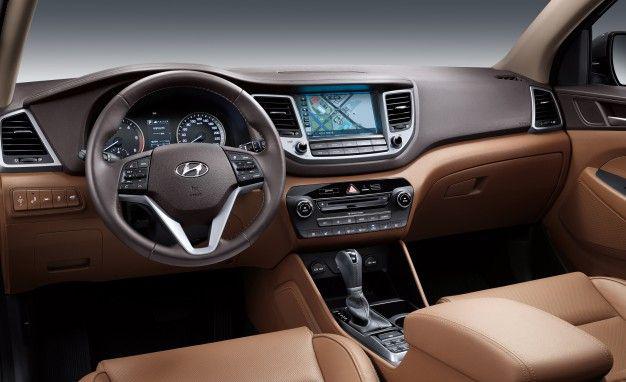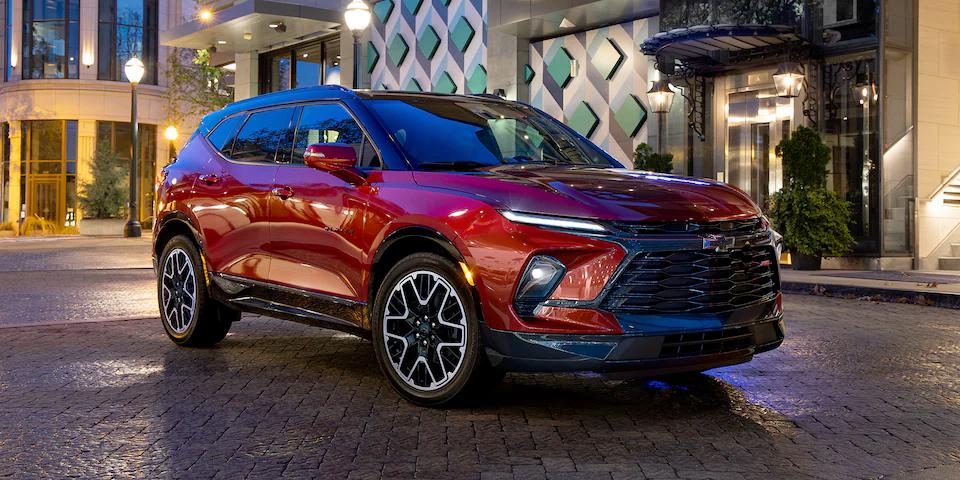Affordable Excellence: The Best Unsold SUVs Under $15K for 2025
As the automotive market continues to evolve, with numerous options available for budget-conscious buyers, finding a reliable and affordable SUV can be a daunting task. This year, several unsold SUVs are making waves, offering excellent value without compromising on quality or features. Here's a curated list of the best unsold SUVs under $15,000 that you can consider.

1 2016 Honda CR-V
2 2016 Hyundai Tucson
3 2016 Subaru Forester
4 2016 Ford Escape
5 2016 Chevrolet Equinox

| SUV Model | Price | Purpose | Safety Features | Performance | Brand Reputation | Technology Features |
|---|---|---|---|---|---|---|
| 2016 Honda CR-V | ~$14,000 | Family and commuting | Lane departure warning, AEB, rearview camera | 2.4L engine, 185 hp, good fuel efficiency | Known for reliability and resale value | Touchscreen infotainment, Bluetooth connectivity |
| 2016 Hyundai Tucson | ~$13,500 | Urban driving | Blind-spot monitoring, rear cross-traffic alert | 2.0L engine, 164 hp, efficient city driving | Strong warranty and quality reputation | Apple CarPlay, Android Auto compatibility |
| 2016 Subaru Forester | ~$14,200 | Adventure and off-road | EyeSight Driver Assist Technology, AWD | 2.5L engine, 170 hp, excellent handling | Renowned for safety and durability | Spacious interior with intuitive tech |
| 2016 Ford Escape | ~$13,800 | Family and practical use | Rearview camera, parking sensors | Multiple engine options up to 245 hp | Longstanding reputation in the SUV market | SYNC infotainment system |
| 2016 Chevrolet Equinox | ~$12,900 | Family-friendly | Forward collision alert, side blind zone alert | 2.4L engine, 182 hp | Recognized for reliability in compact SUVs | Touchscreen interface with smartphone connectivity |

Additional Mentions
6 2015 Mazda CX-5
7 2014 Nissan Rogue
8 2015 Volkswagen Tiguan
| SUV Model | Price | Purpose |
|---|---|---|
| 2015 Mazda CX-5 | ~$13,500 | Sporty driving experience |
| 2014 Nissan Rogue | ~$13,200 | Family use with cargo space |
| 2015 Volkswagen Tiguan | ~$14,000 | Stylish and practical option |

Key Considerations When Buying a Car
Purchasing a vehicle is a significant decision that requires careful consideration of various factors to ensure that you make the right choice. Here are the key aspects to think about when buying a car, along with detailed explanations for each.
Establishing a budget is the first and foremost step in the car-buying process. This budget should encompass not only the purchase price of the vehicle but also additional costs such as insurance, taxes, maintenance, and fuel.
Total Cost of Ownership: Calculate the total cost of ownership over time, which includes depreciation, fuel costs, insurance premiums, and maintenance expenses. This will help you avoid financial strain in the future.
How to Calculate the Total Cost of Ownership Over Time
When considering the purchase of a vehicle, understanding the Total Cost of Ownership (TCO) is crucial. TCO encompasses all expenses associated with owning and operating a vehicle over its lifetime, providing a comprehensive view beyond just the purchase price. Here's a detailed guide on how to calculate TCO effectively.
Components of Total Cost of Ownership
To accurately estimate TCO, consider the following components:
The initial cost of the vehicle is the starting point for calculating TCO.
- Upfront Purchase Price: This is the total amount paid at the time of purchase.
- Financing Costs: If financing the vehicle, include monthly payments and interest over the loan term. For example, if you finance a car for five years with a 10% down payment, calculate total interest paid during that period.
Depreciation is the reduction in value of the vehicle over time.
- Annual Depreciation Rate: On average, vehicles lose about 15-20% of their value each year. Calculate how much value your vehicle will lose based on its make, model, and age.
- Resale Value: Estimate what you can expect to receive when selling or trading in the vehicle after a certain period.
Insurance costs vary significantly based on factors such as the vehicle type, driver history, and location.
- Get Quotes: Obtain insurance quotes for the specific model you are considering to get an accurate estimate of annual premiums.
- Annual vs. Monthly Costs: Include these costs in your TCO calculation by either using annual totals or breaking them down into monthly expenses.
Fuel expenses are another significant aspect of TCO.
- Fuel Economy: Determine the vehicle's miles per gallon (MPG) or liters per 100 kilometers.
- Average Driving Distance: Estimate your annual mileage (typically around 15,000 miles).
- Fuel Price: Multiply your estimated annual mileage by fuel consumption and current gas prices to calculate total fuel costs.
Regular maintenance and unexpected repairs can add up quickly.
- Scheduled Maintenance: Refer to the vehicle's owner manual for scheduled service intervals and costs.
- Unexpected Repairs: Consider an average annual repair cost based on historical data for that make and model (e.g., $500-$1,000 per year).
Various taxes and fees are associated with vehicle ownership.
- Sales Tax: Calculate sales tax based on your local rate applied to the purchase price.
- Registration Fees: Include annual registration fees and any other recurring costs such as emissions testing or inspection fees.
Don't forget to include other potential costs that may arise during ownership.
- Parking Fees: If applicable, factor in monthly parking costs.
- Tolls: Estimate toll expenses if you frequently use toll roads.
- Car Washes and Miscellaneous Expenses: Include regular cleaning or detailing costs as needed.
To calculate TCO over a specific period (commonly five years), follow these steps:
Sum Up All Costs: Add together all estimated costs from each category above. Create an Annual Breakdown: Divide total costs by the number of years to get an annual cost estimate. Monthly Calculation: For a more granular view, divide annual totals by 12 to find monthly ownership costs.
TCO = Purchase Price + Depreciation + Insurance + Fuel + Maintenance + Taxes + Miscellaneous

Understanding the primary use of the vehicle is crucial in determining which type of car will best suit your needs.
- Daily Commute: If you're mainly using the car for commuting, consider compact cars or hybrids that offer better fuel efficiency.
- Family Needs: For families, larger SUVs or minivans with ample seating and cargo space may be more appropriate.
- Off-Road or Adventure Use: If you plan on off-roading or need a vehicle for rugged terrain, look for SUVs with four-wheel drive capabilities.
Safety should be a top priority when selecting a vehicle. Investigate the safety ratings and features of potential cars.
- Active Safety Features: Look for features like automatic emergency braking, lane departure warning, and blind-spot monitoring.
- Passive Safety Features: Ensure that the vehicle has adequate airbags and strong structural integrity to protect occupants in case of an accident.
The performance characteristics of a vehicle can significantly affect your driving experience.
- Engine Power: Consider whether you need a powerful engine for highway driving or if a smaller engine will suffice for city driving.
- Fuel Efficiency: Evaluate the miles per gallon (MPG) ratings to determine how much you'll spend on fuel over time.
- Handling and Comfort: Test drive vehicles to assess their handling, ride comfort, and noise levels during operation.
The reputation of the brand can influence your decision significantly.
- Reliability: Research brands known for their reliability and customer satisfaction. Brands like Toyota and Honda often receive high marks in these areas.
- Resale Value: Some brands maintain their value better than others; consider how well the car will hold its value over time.
Modern vehicles come equipped with various features that enhance comfort and convenience.
- Infotainment Systems: Check for compatibility with smartphones (Apple CarPlay, Android Auto) and other tech features like navigation systems.
- Comfort Features: Look for options such as heated seats, climate control, and advanced sound systems that can improve your driving experience.
Understanding Vehicle Financing Options
When purchasing a vehicle, understanding your financing options is crucial to making an informed decision. Different types of vehicle financing cater to various needs and financial situations, ensuring that every buyer can find a suitable solution. Here's an overview of the primary vehicle financing options available.
Traditional auto loans are the most common form of vehicle financing, typically offered by banks, credit unions, and other financial institutions.
Many dealerships offer financing options directly to buyers, often in partnership with various lenders.
Leasing a vehicle involves paying for the use of the car over a specific period rather than purchasing it outright.
Balloon financing offers lower monthly payments by deferring a large portion of the loan balance to the end of the term.
BHPH financing is typically offered by used car dealerships catering to buyers with poor or no credit history.
| Financing Option | Description | Typical Loan Term | Interest Rates | Down Payment | Ownership |
|---|---|---|---|---|---|
| Traditional Auto Loans | Loans from banks or credit unions for purchasing vehicles. | 36 to 72 months | 3% - 7% (varies by credit) | Typically 10% - 20% | Full ownership at loan completion. |
| Dealership Financing | Financing arranged through the dealership, often with various lenders. | 36 to 72 months | 4% - 8% (varies widely) | May vary; some offer zero down | Full ownership at loan completion. |
| Lease Financing | Renting a vehicle for a set period with the option to buy at the end. | 24 to 48 months | N/A (based on depreciation) | Typically low or no down payment | No ownership unless purchased at lease end. |
| Balloon Financing | Lower monthly payments with a large final payment due at the end of the term. | 36 to 60 months | 4% - 6% (varies by credit) | Typically lower than traditional loans | Ownership after final balloon payment. |
| Buy Here, Pay Here (BHPH) | Financing directly through a used car dealership, often for buyers with poor credit. | Varies | Higher rates, typically 10% - 20% | Often low or no down payment | Full ownership at loan completion. |
Remarks
Finding an affordable SUV under $15K in 2025 does not mean sacrificing quality or features. The models highlighted above offer excellent value while combining reliability, safety, and comfort to meet various needs. Whether you're looking for family-friendly options or vehicles that can handle off-road adventures, these used SUVs provide great solutions that won't break the bank. Always conduct thorough research and test drives to ensure you choose the right vehicle that fits your lifestyle perfectly.

-
![]()
Guide to Pet Insurance Trials: Protecting Your Furry Friends Without the Cost
Free pet insurance offers can provide pet owners with an opportunity to explore coverage options without any financial commitment. These trials allow pet owners to experience the benefits of insuranc…
-
![]()
Finding the Right Independent Living Apartments: A Tailored Guide for Seniors on a Budget
This guide explores affordable independent living options for seniors, including budget-friendly communities, financial assistance, and resources for those on a fixed income. Financial and Social Ben…
-
![]()
Harnessing Technology for Business Growth: The Essential Tools for Sales, Advertising, and Cloud Management
In an era where technology drives business success, selecting the right tools is crucial. Companies that effectively utilize sales, advertising, and cloud management platforms can significantly enhan…




